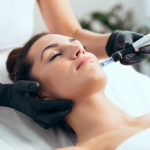Microneedling, also known as collagen induction therapy (CIT), has become a popular procedure in recent years for skin rejuvenation. This is likely due to the many benefits, such as reducing the appearance of wrinkles and fine lines, improving skin texture and tone, and diminishing scarring.
If you’re interested in microneedling, your first step should be to schedule a consultation with a board-certified dermatologist. They will assess your skin and determine if you are a good candidate for the procedure.
Here’s everything you need to know about this treatment before approaching a dermatologist in Southlake, TX.
What is Microneedling?
Microneedling is a minimally-invasive procedure that involves using fine needles to create tiny punctures in the top layer of skin. This stimulates the body’s natural healing process, which leads to the production of new collagen and elastin.
Collagen is a protein that gives our skin its strength and elasticity. Elastin is what allows our skin to bounce back after being stretched or pulled. As we age, our bodies produce less and less of both collagen and elastin, which leads to wrinkles, fine lines, and sagging skin.
Microneedling can help reverse this process by stimulating the body’s natural collagen and elastin production. The procedure can be performed on the face, neck, chest, and other body areas.
How Does Microneedling Work?
During a microneedling procedure, your dermatologist will use a device that contains fine needles. The needles are used to create tiny punctures in the top layer of the skin. The number of needles on the device can vary, but most devices contain between 100 and 300 needles. The depth of the needles can also vary, but they are usually inserted 1 to 2 millimeters below the surface of the skin.
What Are the Benefits of Microneedling?
Microneedling is a minimally invasive cosmetic procedure that can be used to improve the appearance of your skin. This treatment can reduce the appearance of wrinkles, fine lines, and acne scars. The benefits of this treatment are:
Smoother Skin Texture
If you have rough, uneven skin texture, microneedling can help. This treatment can help improve the overall appearance of your skin by reducing the appearance of pores. It can help even out the skin’s surface, giving it a softer, more radiant appearance. The treatment can also help unclog pores, which can improve your skin’s overall complexion.
Helps Delivering Platelet-Rich Plasma (PRP)
Ask your dermatologist about PRP therapy if you’re looking for an added boost to your skin rejuvenation treatment. Platelet-rich plasma is a serum that is derived from your blood.
When it is injected into the skin, it can help to promote the growth of new tissue and collagen. This can lead to improved skin texture, firmness, and overall appearance.
Microneedling can assist PRP by creating channels in the skin that allow the PRP to be delivered more effectively.
Reduced Appearance of Acne Scars
Acne scars can be a source of embarrassment and self-consciousness. Microneedling can help reduce the appearance of acne scars by stimulating the body’s natural collagen production. This can help fill in the depressed areas caused by scarring, making them less visible.
Reduced Appearance of Wrinkles and Fine Lines
Aging is a natural process that everyone goes through, but that doesn’t mean you have to like how it affects your appearance. One of the most common signs of aging is the development of wrinkles and fine lines.
While you may be tempted to get rid of them with over-the-counter creams or treatments, it’s important to remember that the FDA does not regulate these products. This means that they may not be safe or effective.
Your dermatologist can help you achieve smoother, younger-looking skin with microneedling. This treatment uses a device to create tiny punctures on the skin’s surface. It triggers the body to produce new collagen, which helps reduce the appearance of wrinkles and fine lines.
How Many Treatments Will You Need?
The number of treatments you will need will vary depending on your individual needs and goals. Most people require 3-5 treatments to achieve the desired results. Your dermatologist will be able to give you a better idea of how many treatments you will need based on your specific situation.
Is Microneedling Safe?
Yes, microneedling is a safe and effective treatment. It is minimally invasive and does not require any downtime. You may experience some mild discomfort during the treatment, but this can be easily treated with a topical numbing cream.
The most common side effects of microneedling are redness and bruising. These side effects typically resolve within a few days. You may experience more serious side effects such as infection or scarring in rare cases. It is essential to discuss any concerns with your dermatologist in Southlake, TX, before undergoing treatment.
What to Expect After Treatment?
After treatment, your skin will be slightly red and swollen. This is normal and will resolve within a few hours. You may also experience mild bruising, which will resolve within a week or two.
Avoid sun exposure after treatment. Your skin will be more sensitive to the sun, and you may be more prone to sunburn. Use sunscreen with an SPF of 30 or higher when you are outside.
How We Help You
If you are interested in microneedling, the first step is to schedule a consultation with your local Southlake, TX dermatologist. They will be able to assess your skin and determine if this treatment is proper for you.
They will also be able to answer any questions you may have about the procedure and help you to understand what to expect.
If you are looking for a way to improve your skin’s appearance, microneedling may be the right treatment. Your dermatologist can help you to achieve the best possible results.
Contact Compassion Dermatology for Microneedling Treatment
Compassion Dermatology offers microneedling treatments to help improve the appearance of your skin. If you are interested in this treatment, contact us today to schedule a consultation. We would be happy to answer any questions you have and help you get started on the path to beautiful, healthy skin.


